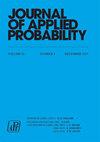Geometric random intersection graphs with general connection probabilities
IF 0.7
4区 数学
Q3 STATISTICS & PROBABILITY
引用次数: 0
Abstract
Let具有一般连接概率的几何随机相交图
让 $\mathcal{V}$ 和 $\mathcal{U}$ 是 $\mathbb{R}^d$ 上两个独立同质泊松过程的点集。首先以 $g(v-u)$ 的概率将 $v\in\mathcal{V}$ 和 $u\in\mathcal{U}$ 独立的点对 (v, u) 连接起来,就构建了一个顶点集为 $\mathcal{V}$ 的图 $\mathcal{G}_\mathcal{V}$ 、其中 g 是一个非递增的径向函数,然后连接两个点 $v_1,v_2\in\mathcal{V}$ 当且仅当它们有一个共同的邻居 $u\in\mathcal{U}$ 。这就产生了 $\mathbb{R}^d$ 上的随机交集图。此外,该图的渗流特性根据 g 的有界或无界支持而有所不同。
本文章由计算机程序翻译,如有差异,请以英文原文为准。
求助全文
约1分钟内获得全文
求助全文
来源期刊

Journal of Applied Probability
数学-统计学与概率论
CiteScore
1.50
自引率
10.00%
发文量
92
审稿时长
6-12 weeks
期刊介绍:
Journal of Applied Probability is the oldest journal devoted to the publication of research in the field of applied probability. It is an international journal published by the Applied Probability Trust, and it serves as a companion publication to the Advances in Applied Probability. Its wide audience includes leading researchers across the entire spectrum of applied probability, including biosciences applications, operations research, telecommunications, computer science, engineering, epidemiology, financial mathematics, the physical and social sciences, and any field where stochastic modeling is used.
A submission to Applied Probability represents a submission that may, at the Editor-in-Chief’s discretion, appear in either the Journal of Applied Probability or the Advances in Applied Probability. Typically, shorter papers appear in the Journal, with longer contributions appearing in the Advances.
 求助内容:
求助内容: 应助结果提醒方式:
应助结果提醒方式:


